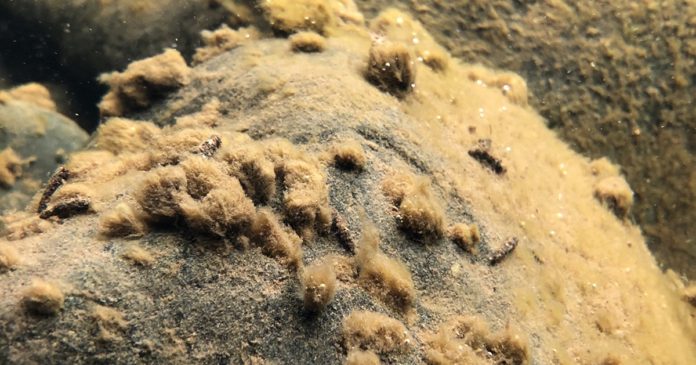For Minnesota fisheries researcher Heidi Rantala and algae expert Mark Edlund, it’s as if aliens have landed on the North Shore.
The two scientists are on a fast-paced mission to explain the shocking growth of a messy algae known as Rock Snot in eight Lake Superior tributaries. It is feared but not yet known if the slippery brown mats of algal blooms will bring harm to the lake’s herring and trout — fish populations that Great Lakes biologists have worked to protect for the past 60 years.
“It fundamentally changes what’s happening in those streams,” said Edlund, senior scientist at the Science Museum of Minnesota’s St. Croix Watershed Research Station. “We’re throwing everything we have at it.”
Similar in texture to wet toilet paper, Rock Snot has been known in Canada to disrupt trout stream food webs by impairing habitat needed for the production of mayflies, stoneflies and caddisflies. Those bugs provide food for the fish and have declined in number as Rock Snot multiplies.
Another thrust of research on the North Shore is to explore whether Rock Snot is wrecking habitat needed by fish to spawn.
“It’s considered native to Lake Superior but we’ve never found it where we are finding it,” said Rantala, who works in the North Shore fisheries office of the Department of Natural Resources.
Rock Snot growth in Lake Superior was studied in the early 2000s by the U.S. Environmental Protection Agency and University of Minnesota. But the blooms weren’t located in stream beds and were considered well-behaved. That changed in 2018 when the alga was discovered in the Poplar River, several tenths of a mile upstream from the lake.
“That was the kick in the pants that got us going,” Edlund said. “To see it there was shocking. It doesn’t belong there.”
The research group immediately sought funding, attracting support from the Minnesota Legislative-Citizen Commission on Natural Resources. The process culminated last summer, delivering an appropriation of $200,000 to jump-start fieldwork in 24 North Shore streams from the Lester River in Duluth to the Grand Portage River at the tip of Minnesota’s Arrowhead. Strangely, no Rock Snot was found in the Poplar. But the invader turned up in seven other places: the Caribou, Devil Track, Flute Reed, Carlson, Kadunce, Kimball and Onion rivers.
“It’s been such a shock that we’ve shifted a lot of our research to it,” Edlund said. “We’ve got to understand it before we can fully deal with it.”
Within a couple of weeks, the fieldwork will continue. Besides re-surveying, the 24 streams in search of Didymo — the shortened scientific name for Rock Snot — crews will examine the stomachs of the streams’ aquatic bugs, check water chemistry, record temperatures and measure stream flows.
For now, researchers are trying to answer two fundamental questions: Did a new strain of Rock Snot arrive in Minnesota? Or have conditions in the environment changed in a way that gives age-old Didymo new places to flourish? The probe will include DNA analysis, including close looks at related bacteria and comparisons to Didymo collected elsewhere in North America. The team includes Robert Pillsbury from the University of Wisconsin–Oshkosh and a DNR dive team that will extend sampling this July into near-shore depths of Lake Superior.
Rantala said Minnesota intends to share its findings and hopefully collaborate with Didymo researchers elsewhere in North America and the world. Rock Snot mats have become nuisances in Colorado, Michigan, the Black Hills, Ontario, New Zealand, Chile, Iceland and elsewhere. The alga thrives in water that is cold, moving and low in nutrients. It can reproduce rapidly and completely cover stream bottoms.
The longest specimens taken last year from North Shore streams were only about two centimeters long, but Rock Snot can form into sizable gobs capable of entangling fishing hooks and interfering with the footwork of stream anglers. While Didymo cells themselves are microscopic, they form easily identifiable, mucilage-layered stalks that cling to rocks.
Rantala and Edlund said Minnesota’s response to Rock Snot includes a call to action for trout stream anglers and other North Shore visitors. Though not technically considered an invasive species at this point, Rock Snot should be treated as such by anyone who wades into a North Shore stream, they said. Any footwear or other gear that touches the water should be drained, decontaminated and dried before it enters another stream.
Rantala has met with North Shore angling groups as part of a larger educational campaign that’s still ramping up. One of the primary teachings is that the felt-soled boots ubiquitous in fly fishing are “probably the biggest culprit” in spreading Rock Snot from stream to stream, Edlund said.
The slip-resistant felt stays wet for long periods and is difficult to neutralize.
“We have to work on people’s mindsets that this really matters,” Edlund said.
Another challenge for the DNR will be to encourage citizens to report Rock Snot findings along Superior’s shoreline or upstream in the North Shore’s forests. Rantala and Edlund recommend that sightings be reported via www.eddmaps.org/midwest/ or www.inaturalist.org.
Credit: Source link































